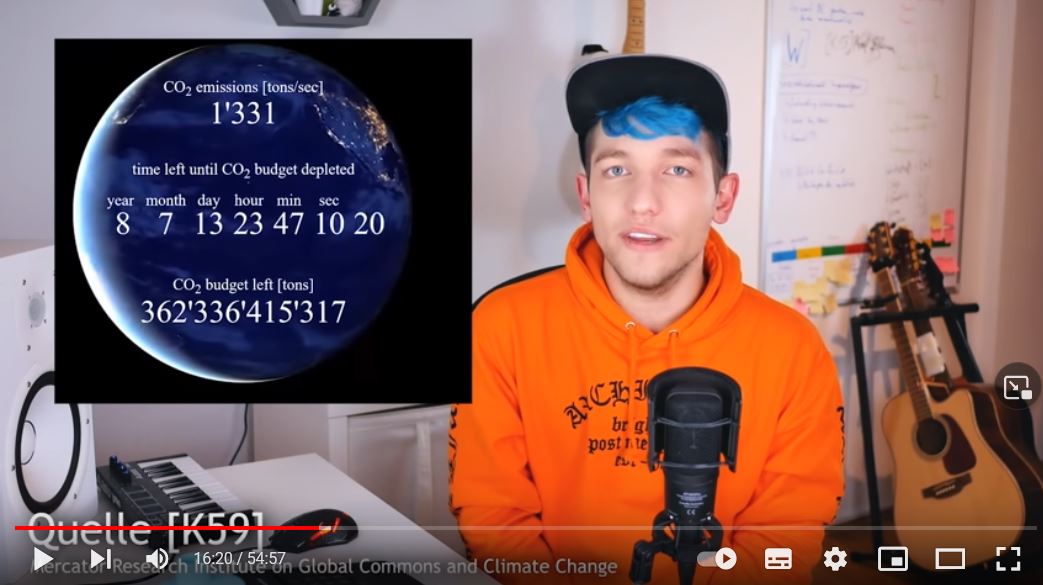
I recently had the opportunity to talk with Joachim Allgaier, Professor for Communication and Digital Society at the Fulda University of Applied Sciences in Germany, about how video platforms such as YouTube support science communication and influence political decisions. This month’s GeoPolicy blog post explores some of the benefits of having an accessible online source of information and whether scientists should tap into it more!
The way in which we acquire and share information has changed dramatically in the last two decades with greater internet accessibility and the rise of social media. Specifically, the way in which people use the video-sharing platform YouTube has also evolved over the years. Early videos published after the platform’s launch in 2005 were generally short with limited editing, but following YouTube’s offering monetisation for videos, from 2007, the number of creators and the quality (and length) of videos increased exponentially. YouTube is now not only used for entertainment, but also as a key source of news and information, for people around the world. In the US, 26% of adults use YouTube as a source of news while in Germany, YouTube was found to be the second most popular site for acquiring knowledge and information after Google. Successful YouTubers who focus on science communication content often have millions of subscribers and spend time interacting with their audience and engaging in a dialogue. This two-way interaction can help creators seem more authentic and transparent, something that traditional media sources and institutions often struggle with.
There are a multitude of studies that aim to better understand the role of online video-sharing and online platforms. Having access to and being able to interact with information whenever and from whomever we choose has huge implications for our society and democracy, both positive and negative. Some of the challenges of living in an increasingly open and online world were explained in last year’s GeoPolicy post on Technology and democracy but there are also benefits to our increasing access to diverse sources of information. Joachim Allgaier highlighted some of the positive impacts such as a recent case of a YouTuber who went viral for communicating the science behind climate change and why it should be a major election issue to an audience correlated around music and entertainment content more than science communication.
Rezo on Germany’s climate policies and inaction
A week prior to the European elections in 2019, a YouTuber called Rezo made an almost hour-long video criticising the German government’s climate change policies and inaction. The video, which has amassed over 19 million views to date, uses an extensive list of scientific references and highlights the likely consequences of rising temperatures on topical issues such as biodiversity, public health, food security, and increased global migration.

Rezo outlining the likely consequences of rising temperatures in his video, Die Zerstörung der CDU.
Allgaier, who researched the case study, explained that initially no one in the media or government took him seriously despite the video going viral because he was a young YouTuber with blue hair. When the German government did eventually publish a document to refute the claims made in his video, numerous well-known German YouTubers, scientists, and science communicators came out in support of Rezo’s video, spreading its message further.
Germany’s Green Party received more than a third of the votes from first-time voters in the following election and became the second largest party in a national-level election. While there isn’t evidence to show that Rezo’s video impacted the election results, there were several commentators who believed this to be the case. Regardless of its direct impact, this video highlighted the potential influence that professional YouTubers can have, particularly in reaching a younger demographic that political parties often struggle to resonate with.
The rise of science communication on YouTube
YouTube’s most popular science content is highly cinematographic, creative, and well formatted. The channel’s host is generally a skilled and charismatic communicator who understands how to connect with their target audience, effectively use emotion, edit postproduction, and work with YouTube’s frequently changing algorithm.
Rezo’s pre-established authenticity on non-science topics also helped his video on Germany’s climate policies gain traction as Allgaier explained, “His followers most likely already perceived him as an authentic and credible person. This is likely to be what attracted so many young people to watch his video in the first place.” Rezo’s ability to collaborate with other popular German YouTubers also spread the video to groups who may not have seen it otherwise.
However, it’s not only Rezo’s perceived authenticity and network that have made him so successful. Allgaier emphasised Rezo’s proficiency in communication, “Some scientific organisations in Germany are recommending that the public watch his videos because he does a good job of explaining the climate crisis to a broad audience and using language that can be understood by almost everybody”.
Should scientists and research institutions be working with popular YouTubers?
Rezo’s authenticity, communication skills, network of potential collaborators, editing skills and committed audience are not something that can be easily replicated. Allgaier describes Rezo’s videos as high-quality and well-structured, but unlike many videos produced by scientific organisations and various government agencies, he communicates casually and uses colloquial language as well as emotion.
Researchers and research institutions have many other focus areas and often find it challenging to connect with such a diverse audience. Keeping up with changes to the YouTube algorithm and generating fast-paced quality content is also incredibly time consuming. As a result, it’s difficult for research institutions to match the quality and engagement of YouTube professionals who rely on the platform for their income. Allgaier believes that a more effective way of engaging with YouTube would be to work with existing experts,
“I think when it comes to impact, it probably makes more sense [for institutions] to engage with people who have a very large audience on social media platforms, especially on YouTube.”
It will take practice and patience for scientific organisations to understand how to select, connect with and efficiency work alongside professional YouTubers. However, these collaborations could be incredibly powerful and result in highly engaging and effective science communication content that influences a young and diverse audience otherwise hard to reach.
A big thank you to Joachim Allgaier for working on the topic and taking the time to talk with the EGU about it!
Further reading
- Allgaier, J. (2020). Rezo and German climate change policy: The influence of networked expertise on YouTube and beyond. Media and Communication, 8(2), 376-386.
- Velho, R. M., & Barata, G. (2020). Profiles, challenges, and motivations of science YouTubers. Frontiers in Communication, 95.
- Allgaier, J., Landrum, A. R., eds. (2022). New Directions in Science and Environmental Communication: Understanding the Role of Online Video-Sharing and Online Video-Sharing Platforms for Science and Research Communication. Lausanne: Frontiers Media SA. doi: 10.3389/978-2-88974-364-3






Dedi Purwana
Thank you for sharing a great article.